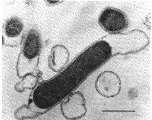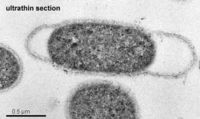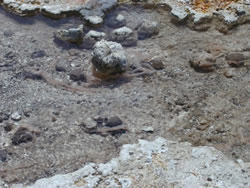Thermotoga
|
NCBI: |

Classification
Higher order taxa:
Bacteria; Thermotogae; Thermotogae (class); Thermotogales; Thermotogaceae
Species:
Thermotoga:
T. elfii, T. hypogea, T. lettingae, T. maritima, T. maritima MSB8, T. naphthophila, T. neapolitana, T. petrophila, T. subterranea, T. thermarum, T. sp., T. sp. strain FjSS3-B.1
Petrotoga:
P. mexicana, P. miotherma, P. mobilis, P. olearia, P. sibirica
Description and Significance
Thermotoga is typically a rod-shaped cell enveloped in a outer cell membrane (the 'toga'). Thermotoga enzymes are known for being active at high temperatures. Thermotogales are extremely thermostable and therefore useful for many industrial processes such as in chemical and food industries (R. Huber et al., 2004). To learn about Petrotoga mexicana, a novel anaerobic, thermophilic, xylanolytic, motile rod-shaped bacterium (complete with a characteristic sheath-like outer structure or 'toga') that was isolated from a Mexican oil well in the Gulf of Mexico, go HERE.
Genome Structure
The genome structure of T. maritima consists of one circular chromosome comprised of 1,860,725 base pairs (46% average G+C content). This genome has 1,877 predicted coding regions, with only 54% (1,014) having known functional assignments. Since the completion of the T. maritima genome, it has been discovered that almost one quarter of the genome has an archaeal background, though the core of T. maritima may be eubacterial (TIGR, 2004). Petrotoga is still fairly new, and is currently being sequenced.
Cell Structure and Metabolism


Thermotogales are thermophilic or hyperthermophilic, growing best around 80°C and in the neutral pH range (R. Huber et al., 2004). The salt tolerance of Thermotoga species varies greatly; while some display an extremely high salt tolerance, others are restricted to low-salinity habitats. This aerobic gram-negative organism is typically nonsporeforming and metabolizes several carbohydrates, both simple and complex, including glucose, sucrose, starch, cellulose, and xylan (EBI, 2003). The L-alanine production of Thermotogales is similar to the achaeal Thermococcales, suggesting that L-alanine production from sugar is a trait of a former ancestral metabolism (R. Huber et al., 2004).
Ecology

Thermotoga bacteria has an upper growth limit of 90°C , making it among the bacteria group with the highest known growth temperatures. Thermotogales typically grow in low salinity volcanic or high-temperature habitats such as shallow or deep-sea marine systems and continental oil fields. T. maritima was first isolated in Vulcano, Italy from a shallow marine sediment that was geothermally heated . The next species found was T. neapolitana, found in a thermal submarine vent near Naples, Italy. The newest Thermotoga species BB13-1-L6A lives in heated waters close to 68°C with a pH of 6.8 in Germany (R. Huber et al., 2004). Petrotoga species are only found in oil reservoirs, which has only raised questions about both their survival in this deep subsurface environment and their possible indigenicity to this peculiar ecosystem.
References
European Bioinformatics Institute. 19 Dec 2003. Proteome Analysis.
The Institute for Genomic Research: TIGR Microbial Database. 2004. Thermotoga maritima background.
Lunar and Planetary Institute. 2002. Octopus Spring Expedition.
"Miranda-Tello+E"[Author Miranda-Tello E, Fardeau ML, Thomas P, Ramirez F, Casalot L, Cayol JL, Garcia JL, Ollivier B. "Petrotoga mexicana sp. nov., a novel thermophilic, anaerobic and xylanolytic bacterium isolated from an oil-producing well in the Gulf of Mexico." Int J Syst Evol Microbiol. 2004 Jan;54(Pt 1):169-174.]
White, T., R. Santos. Palaeos: The Trace of Life on Earth. Mar 2002. Eubacteria: Thermotogales.
